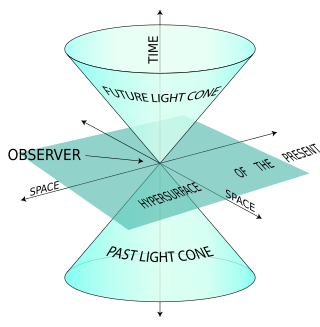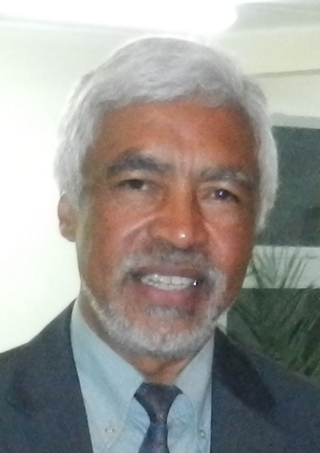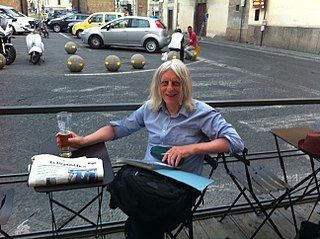Related Research Articles

In theoretical physics, quantum chromodynamics (QCD) is the theory of the strong interaction between quarks mediated by gluons. Quarks are fundamental particles that make up composite hadrons such as the proton, neutron and pion. QCD is a type of quantum field theory called a non-abelian gauge theory, with symmetry group SU(3). The QCD analog of electric charge is a property called color. Gluons are the force carriers of the theory, just as photons are for the electromagnetic force in quantum electrodynamics. The theory is an important part of the Standard Model of particle physics. A large body of experimental evidence for QCD has been gathered over the years.

In physics, lattice gauge theory is the study of gauge theories on a spacetime that has been discretized into a lattice.
Hadronization is the process of the formation of hadrons out of quarks and gluons. There are two main branches of hadronization: quark-gluon plasma (QGP) transformation and colour string decay into hadrons. The transformation of quark-gluon plasma into hadrons is studied in lattice QCD numerical simulations, which are explored in relativistic heavy-ion experiments. Quark-gluon plasma hadronization occurred shortly after the Big Bang when the quark–gluon plasma cooled down to the Hagedorn temperature when free quarks and gluons cannot exist. In string breaking new hadrons are forming out of quarks, antiquarks and sometimes gluons, spontaneously created from the vacuum.
Perturbative quantum chromodynamics is a subfield of particle physics in which the theory of strong interactions, Quantum Chromodynamics (QCD), is studied by using the fact that the strong coupling constant is small in high energy or short distance interactions, thus allowing perturbation theory techniques to be applied. In most circumstances, making testable predictions with QCD is extremely difficult, due to the infinite number of possible topologically-inequivalent interactions. Over short distances, the coupling is small enough that this infinite number of terms can be approximated accurately by a finite number of terms. Although only applicable at high energies, this approach has resulted in the most precise tests of QCD to date.
In particle physics, the parton model is a model of hadrons, such as protons and neutrons, proposed by Richard Feynman. It is useful for interpreting the cascades of radiation produced from quantum chromodynamics (QCD) processes and interactions in high-energy particle collisions.
The J. J. Sakurai Prize for Theoretical Particle Physics, is presented by the American Physical Society at its annual April Meeting, and honors outstanding achievement in particle physics theory. The prize consists of a monetary award (US$10,000), a certificate citing the contributions recognized by the award, and a travel allowance for the recipient to attend the presentation. The award is endowed by the family and friends of particle physicist J. J. Sakurai. The prize has been awarded annually since 1985.
In theoretical physics, the anti-de Sitter/quantum chromodynamics correspondence is a goal to describe quantum chromodynamics (QCD) in terms of a dual gravitational theory, following the principles of the AdS/CFT correspondence in a setup where the quantum field theory is not a conformal field theory.
Igor Romanovich Klebanov is an American theoretical physicist. Since 1989, he has been a faculty member at Princeton University where he is currently a Eugene Higgins Professor of Physics and the Director of the Princeton Center for Theoretical Science. In 2016, he was elected to the National Academy of Sciences. Since 2022, he is the Director of the Simons Collaboration on Confinement and QCD Strings.
William Allan Bardeen is an American theoretical physicist at Fermi National Accelerator Laboratory. He is the son of John Bardeen and Jane Maxwell Bardeen.

Richard Keith Ellis, is a British theoretical physicist, working at the University of Durham, and a leading authority on perturbative quantum chromodynamics and collider phenomenology.

The light-front quantization of quantum field theories provides a useful alternative to ordinary equal-time quantization. In particular, it can lead to a relativistic description of bound systems in terms of quantum-mechanical wave functions. The quantization is based on the choice of light-front coordinates, where plays the role of time and the corresponding spatial coordinate is . Here, is the ordinary time, is one Cartesian coordinate, and is the speed of light. The other two Cartesian coordinates, and , are untouched and often called transverse or perpendicular, denoted by symbols of the type . The choice of the frame of reference where the time and -axis are defined can be left unspecified in an exactly soluble relativistic theory, but in practical calculations some choices may be more suitable than others.

Mikhail "Misha" Arkadyevich Shifman is a theoretical physicist, formerly at Institute for Theoretical and Experimental Physics, Moscow, currently Ida Cohen Fine Professor of Theoretical Physics, William I. Fine Theoretical Physics Institute, University of Minnesota.
In physics, vector meson dominance (VMD) was a model developed by J. J. Sakurai in the 1960s before the introduction of quantum chromodynamics to describe interactions between energetic photons and hadronic matter.
George Franklin Sterman is an American theoretical physicist and the Director of the C. N. Yang Institute for Theoretical Physics at Stony Brook University where he holds the rank Distinguished Professor.
André Neveu is a French physicist working on string theory and quantum field theory who coinvented the Neveu–Schwarz algebra and the Gross–Neveu model.
Davison "Dave" Eugene Soper is an American theoretical physicist specializing in high energy physics.

Stephan Narison is a Malagasy theoretical high-energy physicist specialized in quantum chromodynamics (QCD), the gauge theory of strong interactions. He is the founder of the Series of International Conferences in Quantum Chromodynamics (QCD-Montpellier) and of the Series of International Conferences in High-Energy Physics (HEPMAD-Madagascar).

Gavin Phillip Salam, is a theoretical particle physicist and a senior research fellow at All Souls College as well as a senior member of staff at CERN in Geneva. His research investigates the strong interaction of Quantum Chromodynamics (QCD), the theory of quarks and gluons.

Tomasz Robert Taylor is a Polish-American theoretical physicist and faculty at Northeastern University in Boston, Massachusetts, United States of America. He obtained his PhD degree from the University of Warsaw, Poland in 1981 under the supervision of Stefan Pokorski. He is a descendant of John Taylor who originated from Fraserburgh in Scotland and emigrated to the Polish-Lithuanian Commonwealth c.1676.

Hugh Osborn is a British theoretical high-energy physicist and a professor emeritus at the University of Cambridge, Department of Applied Mathematics and Theoretical Physics. He is known for his work on Conformal Field Theory and Quantum Field Theory.
References
- ↑ "2009 J. J. Sakurai Prize for Theoretical Particle Physics Recipient". APS. Retrieved 13 August 2014.
- 1 2 "John Collins Penn State Profile". Archived from the original on 22 October 2018. Retrieved 14 August 2014.
- ↑ Collins, John C.; Soper, Davison E.; Sterman, George (1985). "Transverse Momentum Distribution in Drell-Yan Pair and W and Z Boson Production". Nuclear Physics B. 250 (1–4): 199–234. Bibcode:1985NuPhB.250..199C. doi:10.1016/0550-3213(85)90479-1.
- ↑ Collins, John C.; Soper, Davison E.; Sterman, George (1985). "Factorization for short distance hadron-hadron scattering". Nuclear Physics B. 281: 104–142. Bibcode:1985NuPhB.261..104C. doi:10.1016/0550-3213(85)90565-6.
- ↑ John C. Collins, Davison E. Soper and George Sterman (1989). "Factorization of Hard Processes in QCD". In Mueller, A. H (ed.). Perturbative Quantum Chromodynamics. World Scientific. pp. 1–92.
- ↑ Collins, John C.; Frankfurt, Leonid; Strikman, Mark (1997). "Factorization for hard exclusive electroproduction of mesons in QCD". Physical Review D . 52 (5): 2982. arXiv: hep-ph/9611433 . Bibcode:1997PhRvD..56.2982C. doi:10.1103/PhysRevD.56.2982. S2CID 15384023.
- ↑ Collins, John C. (1998). "Proof of factorization for diffractive hard scattering". Physical Review D . 57 (5): 3051. arXiv: hep-ph/9709499 . Bibcode:1998PhRvD..57.3051C. doi:10.1103/PhysRevD.57.3051.
- ↑ Collins, John C. (1993). "Fragmentation of transversely polarized quarks probed in transverse momentum distributions". Nuclear Physics B. 396 (1): 161–182. arXiv: hep-ph/9208213 . Bibcode:1993NuPhB.396..161C. doi:10.1016/0550-3213(93)90262-N. S2CID 15966703.
- ↑ Elliot Leader (2005). Spin in Particle Physics. Cambridge University Press. pp. 391–398. ISBN 978-0521020770.
- ↑ John, Collins (1986). Renormalization: An Introduction to Renormalization, the Renormalization Group and the Operator-Product Expansion. Cambridge University Press. ISBN 978-0521311779.
- ↑ John, Collins (2011). Foundations of Perturbative QCD. Cambridge University Press. ISBN 978-1107645257.